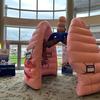Lung cancer is the most common cause of cancer-related deaths in the world, and West Virginia has one of the highest incidence rates and worst outcomes for the disease.
Early detection is the most effective way to tackle lung cancer.
More than 70% of all lung cancer nodules are in the tiny outer parts of the lung that can be hard to navigate. Traditionally, physicians would have to cut open the patient’s chest to get a sample to test for cancer.
Now, doctors at CAMC are using a robotic navigation system to go through the patient’s mouth and windpipe to access the lungs and tiny suspicious nodules alleviating the need for open surgery.
“When we are doing a biopsy with ION, a robotic platform, we can sample lung nodules that are very small, which was challenging previously,” said Sidra Raoof, MD, CAMC Interventional Pulmonologist. “We are able to get a diagnosis more accurately in most cases. So it helps reduce the time between diagnosis and treatment.”
A biopsy is an examination of tissue to discover the presence or extent of a disease.
“Once we find the lung nodule, test and diagnose it using the robotic system, we can mark them and on the same day, while the patient is already under anesthesia, perform a robotic-assisted lung sparing surgery,” said Sandeep Kashyap, MD, CAMC Thoracic Surgeon. “I am proud to be a part of the system where we have state-of-art- technology available to diagnose and treat lung cancer at an early stage.”
“It’s a game changer,” Raoof said. “Being able to detect cancer sooner and start treatment in earlier stages improves survival for patients.”



